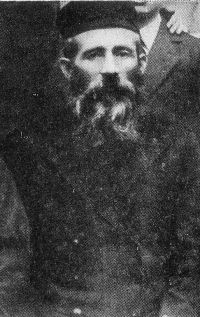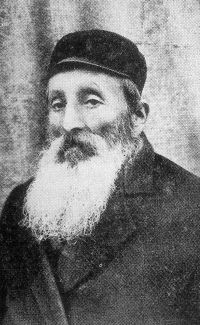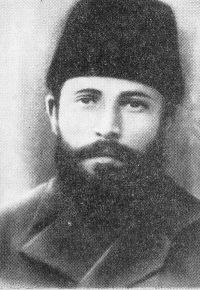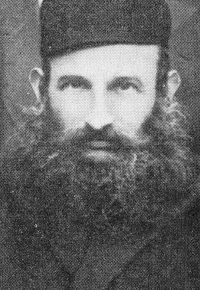Czyzewo
My Aleksander Shtibl
by Berl Szajes/Tel Aviv
Translated by Gloria Berkenstat Freund
I spent my most wonderful young years in this shtibl [small Hasidic house of prayer; shtiblekh is the plural]. Everything I saw there, heard and experienced is deeply etched in my memory. It was a time when it seemed to us that the Aleksander shtibl had developed together with the shtetl [town], as if it had existed since the origin of the community in Czyzewo. Later it became clear to me that the Jewish settlement in Czyzewo consisted of superb Jews, scholars and craftsmen who studied Torah, and led a warm Jewish life much earlier than the rise of the Hasidic movement.
It was just after the death of the old “Wurker” that the later Aleksander Hasidim began to develop. Around 100 years ago, Reb Yeheil Danciker, the son of Reb Feywele Gricer, a grandson of the great Warsaw rich man, scholar and misnagid [opponent of Hasidism], Reb Tzwi Hersh Danciker, took over the management and created the first minyon [ten men needed for prayer; minyonim in the plural] of scholarly young men, who were strong adherents of the new customs and began going in his path, singing the nigumim [melodies], keeping to his manner of praying.
At that time Czyzewo began to sense the differences between the Ger and Aleksander Hasidim. Reb Borukh Szapira advised and urged traveling to the Sfas Emes [the Ger Rebbe Yehudah Leib Alter].
Those who were not inclined to the Kotsker style [style of the Hasidim from Kock] created the Aleksander shtibl.
Until the great fire in 5638 [1878], the synagogue stood at the location of the Beis-haMedrash [house of study and prayer] (which today serves as the grain storehouse for the non-Jews of Czyzewo). The Hasidic minyonim developed unexpectedly in rented apartments. After the fire, a large city Beis-haMedrash was built at another spot and, in the second story over the Beis-haMedrash, the shtiblekh of the Hasidim were built. The Aleksander shtibl occupied the smallest part, perhaps half the size of the neighboring Gerer.
This was a long, large hall with three windows on the south side that looked out onto the old cemetery. The hall was divided by a large tiled oven with seats around it that served not only for the old men to take an occasional nap, but also as a mechitza [dividing wall] between the students and talkers.
Every morning, they prayed in a minyon. Before praying, from the earliest morning hours, young men, kest eidems [sons-in-law who were given financial support by their fathers-in-law], would sit and study a lesson in Talmud. The foremost wood merchant, Reb Zelik Yekl Pszakewicz; Epsztajn's son-in-law, a Litvak arrival from Wisoke, Reb Yizroel Yitzhak Janowski; the shtibl regular, Reb Moshe Prawda, a Jew, a scholar and great joker. Sura Ete's Reb Dovid; Shimeon Nusan Nejmark; Reb Meir Rikhter, a father-in-law of Reb Yisroel Tiktin and eminent merchant of wool and wheat. Meir Rikhter was not actually a real Aleksander [Hasid], but after the death of the old Wurker [Rebbe], he became involved with Skierniewice Hasidim. But, as a result of circumstances, after the death of the old Kotsker [Kock] Rebbe, he no longer traveled to a rebbe and he was a worshiper in the Aleksander shtibl. As a result, his son and grandson were real Aleksander Hasidim. The prayer in the Aleksander shtibl was on time and after the morning prayers the members of the congregation each left for their businesses and to eat breakfast. After breakfast, only the kest-eidems returned to study.
At minkhah, the group again appeared and each took to his book anew, some to study, some to teach a page of gemara with commentaries, and thus it extended until late at night.
Entering the shtibl to study was not an obligation, but a right. The majority who took advantage of this had small residences and simply did not have enough space for studying or because their children interrupted them. Those who had good, comfortable apartments came only to pray in public.
The Aleksander path was not to study for the sake of publicity, not to make an impression, but simply because a Jew needs to study, a Jew must learn and mainly because a Jew who can study also savors his learning. As a matter of course, there was no feeling of any kind of organized study in the Aleksander shtibl. Some studied orally, others only browsed.
Prayer in the Aleksander shtibl took place with satisfaction, not too much rocking, the Ekhod [oneness of God] not shouted out too loud during the Krishme [prayer said as part of the morning and evening services and when going to bed], not too much excessive talking at the Shemoneh Esrei [18 blessings said at the three daily prayer services].
Naturally, there were also exceptions. Reb Itshe Zilberman, the son of the Prager rabbi and Reb Yisroel Titkin's son-in-law, would rock robustly during prayer and in the end he left to pray in the Gerer shtibl. Naturally, not until after the death of Reb Yisroel Tiktin.
|
|
Reb Elihu Ruwin Malcman |
Reb Welwele Zylbersztajn was also a strict constructionist. Reb Welwele was the bel kore [reader of the Torah during services] in the shtibl and God protect us if he caught the tip of a shin [letter of the Hebrew alphabet] rubbed off. Then nothing was of help. Experts looked over the Torah scrolls and asserted that it was nothing, other Torah readers said it was kosher [could be used], but Reb Welwele stood by his opinion; he would not read further. Whereas, one cannot fast on Shabbos, the Torah scroll had to be exchanged for a different one.
Shabbos in the Shtibl
The melodies for Lekha Dodi [Come my beloved, a song sung to welcome the arrival of the Sabbath] were sustained by the entire congregation and sung by the young boys in the shtibl. A new melody was like a holiday. Kabbalat Shabbat [the welcoming of the Sabbath] belonged mainly to those officiating at the morning service. This was Reb Zelik Yekl Psbezokowicz and the younger generation, Reb Yeshayahu Gozalczani, Reb Butshe Elaisz. Incidentally, his father was a not a Hasid, nor was he a founder of or worshipper with the Khevre Mishnius [Mishnah Society – the Mishnah is the compilation of the “oral laws of the Torah”]. However, he became connected to the Aleksander Hasid, Reb Akiva Zylbersztajn, who was one of those sitting at the rabbi's table in the Aleksander shtibl through marriage. He went to the Aleksander shtibl with his father-in-law because Reb Butshe (Borukh Yakov) was a learned man, a sociable man and also had a sweet voice; he easily made his way to become the bel-Shakharis [person who recites the morning prayer].
There was an agreement with Reb Yeshayahu. He was the main spokesman, not only in shtibl matters, but also in civic matters. In addition, he had a deep feel for music. Therefore, he became the bel-Shakharis as soon as he began praying in a talis [prayer shawl].
Reb Alter Walmer, one of the very young, newly married men, prayed Shakharis. And so did Silke's son-in-law, Reb Moshe'le Blumenkranc. Officiating at the musaf service in the shtibl was Reb Yisroel-Yitzhak Janowski, with a hoarse voice, but with so much sweetness that it was truly a pleasure to listen to him. His delicious praying was renowned in the shtetl. A while later, a Kosower young man arrived, a brother-in-law of Reb Shimeon Nusan, who because of his analytical intellect was called der pikeyekh [the clever man].
The person starting prayers and the person who recited the Minkhah prayer during the Days of Awe and on holidays and also the daily Shakharis also were included in the honored functions in the shtibl. Reb Shlomo Yoshi, a quiet, modest Jew, great scholar and very pious, had this title. After his premature death (he received a blow from a soldier during the 1920's during the Polish-Russian War, when he was seized for herding cattle. After his return, he received another great spiritual blow; his beard was cut off by the Hallertchikes. He could not bear both the physical and the spiritual blow and died young, leaving a house full of small children and an old father, the above-mentioned Hasid, Reb Moshe Prawda). Reb Mendl, the son-in-law of Reb Mendl Jandzewer the baker, took over his mission. Besides the opening prayers and prayers for Minkhah, Reb Mendl also recited the kiddush for Simchas Torah and he was the clown for the shtibl on Purim.
Reb Leyzer Bitner was not only the prayer leader. His praying had the fragrance of cantorial art; he only led the Musaf service on Shabbos in the shtibl. The shtibl had to lend him to the Great Synagogue for the Days of Awe. He led the Musaf service there until the bitter end.
A separate assignment in the shtibl was calling up the men for aliyahs [honor of being called up at the Sabbath service to read a portion of the Torah] and hakofes [circular precession on Simchas Torah marking the completion of the yearly Torah reading] on Simchas Torah. Reb Yisroelke Mankarsz, who would entertain the congregation at the melave-malkes [conclusion of the Sabbath] meals or at regular kiddushn [blessings of wine after the Sabbath service] in the shtibl, carried this on with great charm and humor. His father was a misnagid [opponent of Hasidus], one of the best men in the shtetl.
In the Shabbos dusk, when the congregation came together in the darkness of the shtibl, to end the third Shabbos meal, with the kezayes of challah and a piece of herring, the main attraction was the Shabbos melodies. Reb Yeshayahu sang the “Hallelujahs” – Reb Zelik Yekl, Ki Eshm'rah, later Reb Butshe. The Y'tzaveh belonged to Reb Leizer. There were times when Reb Leizer Soltis (Wengorsz) would sing the “Hallelujahs.” He would also recite the Shakharis prayers. However, he resigned when he grew old. He died before the war at a very old age.
All of the melodies of the various prayers were sung by the young men of the shtibl. Only one Yom Kippur prayer, the Avodah, was sung by Reb Yisroel-Yitzhak Janowski with the assistance of the beli-Shakharis, Reb Yeheshua and Reb Butshe. Even when Reb Butshe would recite the Shakharis prayers in the synagogue, he came to the shtibl for the Musaf prayers.
The Aleksander shtibl drew to it all of the solid middle class, as for example, Reb Fishl Lubelczyk, who came from the Great Synagogue even though his father was an Otwocker Hasid, Reb Eli Dimentman and so on.
A harmonious, amicable atmosphere always reigned among the congregation of those praying. The entire shtibl felt like a large family, each helping the other in their need, with advice and with money… I do not remember any quarrels in the shtibl.
When the Aleksander shtibl had to present candidates for synagogue warden, the people simply had to be coerced, sometimes with the help of “drawing lots.” Thus came Reb Hershl Malinowicz, Reb Zindl Lew, Reb Eli Ruwin Malcman, Reb Alter Walmer, Reb Fishl Lubelczik and others to the warden room. The people changed from term of office to term of office. There were great scholars among the Aleksanderer. Rabbincal diplomas were a natural phenomenon among those in the shtibl, such as Reb Yisroel
|
|
Reb Shmuel Zelik Golombek |
Titkin, Reb Shimeon-Nusan, Reb Mordekhai-Hersh Surka, etc. However, they did not dream of any rabbinical positions. Reb Yisroel Titkin was actually the rabbi in Czyzewo for a short time, but soon resigned and took to business.
More guests were seen in the Aleksander shtibl on a Friday night than anywhere else. Aleksander Hasidim had a reputation as chartable people. The gabai would stand at the door and match a guest for Shabbos with each person, according to how he thought it suitable. Reb Yeshayahu had the concession for eminent guests, such as, for example, emissaries from the Aleksander court, from the yeshivah, who would stay with him for two or three weeks until they finished their business with the shtibl.
The leadership of the shtibl was not elected, but arose by itself, as an automatic hierarchy. During the last years it remained in the hands of Reb Shmuel-Zelik Golombek and Reb Mordekhai Hersh Surka. The latter would say “Ahl da'at ha'ma'kom, v'ahl da'at hakahal,” before Kol Nidre that was usually recited by the rabbi in the synagogue.
The Aleksander Hasidim rarely wore a shtreiml [fur hat worn by married men in many Hasidic sects]; the majority wore silk caftans in honor of Shabbos, not satin, and a velvet cap. Long pressed pants were accepted with polished gaiters, but the innovators, who tried to wear short jackets, could not be endured by Reb Shmuel Zelik. And the followers of modern garb expressed in a direct manner obstinate resistance by leaving the shtibl, but not with a light heart. They longed for this embracing communal atmosphere.
Each Hasidic shtibl had its specific holidays. To these belonged
|
|
||
Reb Alter Garde |
Reb Welwl Zilbersztajn |
the Suim haSefer, the conclusion of the writing of Sefer Torah and the yahrzeit [yearly anniversary of a death] of the rabbis. In about 1912, the Aleksander shtibl concluded the writing of a Torah scroll and at this opportunity, a great celebration was arranged in the large apartment and tavern of Reb Shmuel Zelik. There were torches, lanterns of various colored paper, fireworks, klezmorim [musicians], a feast with plenty of good things to eat and Hasidic dancing until the grey, early morning.
As a rule, the Aleksander shtibl paid more attention to relations between men than to relations between man and God, and they believed in the importance of relating to man and insisted that this was the importance of Hasidus.
The Aleksander Hasidim placed great weight on matters in the economic and social realms. They were willing to help with organizing and leading the Zionist interest free loan fund. Reb Ahron Eibeszic, a son of the Sterdiner Rabbi and Reb Shmuel Zelik's son-in-law, took part in it.
Tolerance was one of the virtues of the Aleksander Hasidim. They tolerated the different sympathies of various worshippers, for example, Zionists, Mizrakhists [religious Zionists], despite the fact that the Aleksander court had a negative attitude toward Zionism. However, many who were spellbound by the idea of returning to Zion and who helped and gave it support could be found among the shtibl attendees. Reb Haim Yehoshua Tencza, a maskhil [follower of the Enlightenment], with great knowledge of Hebrew and other languages, belonged to this group. Almost everyone of my generation learned modern information from him. He was later the secretary of the kehile [religious community]. In general, we met almost no refusals from any Aleksander Hasid when collecting for Zionist funds.
Dozens of faces, whose names have left my memory, stand before my eyes. However, I will never forget their honesty and sincerity, insight, wise outlook on life.



